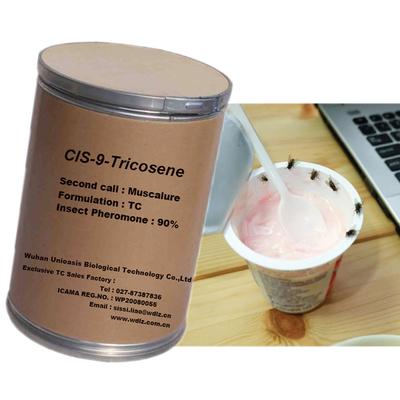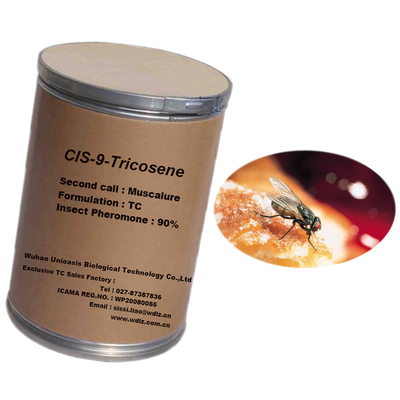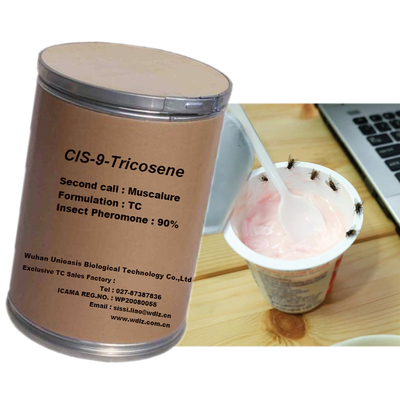-
Biological Insecticides
-
Biological Pesticide
-
Natural Vegetable Insecticides
-
Maize Crop Pesticides
-
Fruit Tree Pesticides
-
Rice Crop Pesticides
-
Cotton Crop Pesticides
-
Tea Tree Insecticide
-
Biological Fungicide
-
Biological Fertilizer
-
Cockroach Bait Gel
-
Home Pest Killer
-
Mosquito Larvae Killer
-
Z-9-Tricosene
-
Fly Killing Bait
-
Ant Killing Bait
Natural Housefly Attractant 90% TC pheromone Rhinoceros Beetle Lure For Vegetable Garden
| Place of Origin | China |
|---|---|
| Brand Name | Unioasis |
| Certification | Pesticide Registration Certificate |
| Model Number | 90% TC |
| Minimum Order Quantity | 100kg |
| Price | $860 |
| Packaging Details | at least 1kg. Chinese package and support customize |
| Delivery Time | 7days |
| Payment Terms | L/C, T/T, Western Union |
| Supply Ability | 50000kg per week |

Contact me for free samples and coupons.
WhatsApp:0086 18588475571
Wechat: 0086 18588475571
Skype: sales10@aixton.com
If you have any concern, we provide 24-hour online help.
x| Pest Control | House Flies, Stable Flies And Blow Flies | Classification | Insect Pheromone |
|---|---|---|---|
| ICAMA REG.No. | WP20080055 | Formulation | TC |
| Active Ingredient | Z-9-Tricosene 90% | Application | Sex Pheromones For The Female Housefly |
| Other Name | Cis-9-Tricosene, Muscamone, (Z)-9-Tricosene, (9Z)-tricos-9-ene, (9E)-tricos-9-ene, Z9-Tricosine | Supply Type | Stock |
| OEM/ODM | Support Customize | Logo | Support Customize |
| Shipping Way | Sea Land Air | Shelf Life | 2 Years |
| Highlight | Vegetable rhinoceros beetle lure,rhinoceros beetle lure,pheromone lure for rhinoceros beetle |
||
Housefly Pest Attractant Fly Trap Cis-9-Tricosene 90% TC Insecticide Insects Bait
Common Name: (Z)-9-tricosene
Chemical Name: (Z)-9-tricosene
Chemical Family: Biochemical (pheromone)
CAS Registry Number: 27519-02-4
OPP Chemical Code: 103201
Empirical Formula: C23H46
Other Name: muscalure, muscamone
| Ingredients | CAS NO. | Content, % |
| Muscalure | 27519–02–4 | 90% min |
| Other ingredients | - | 10% max |
![]()
(Z)- 9-Tricosene is classified as a biochemical pesticide because, even though chemically
synthesized, it is identical to the sex pheromone of the female house fly Musca
domestica. Also, it is used as an insect attractant with a "non-toxic" mode of action.
The active ingredient is used in other formulations as a fly attractant and products are
applied at sites noted above
Features:
2.Muscalure is widely used combined with insecticides to enhance the killing ability.The suggest dose in formulation is 0.05-0.5%.
3.Muscalure is to gather insects to entice the pest to gather and feed, and to kill the pests. As the male and female housefly sex attractant, mating disruption, sometimes as poison and mixed pesticides.
(Z)-9-tricosene may be applied by hand using rubber gloves, cup, or a
scoop. In addition, a rotary hand held duster may be used at some sites.
Application rates are approximately 0.08%. However, all product
labels do not give enough specific information, to determine the exact rates,
especially those labels of products with impregnated formulations.
accidental ingestion can be vomiting .Wash affected skin or eyes with plenty of water ,Get medical attention if feeling unwell.
1. This product should be stored in a cool and ventilated place to avoid high temperature and strong sunshine
2. Keep away from food, drink and animal feeding stuffs.
3. Keep locked up out of the reach of children .
![]()
Q1. Is it organic pesticide ?
Yes, it is an organic pesticide ,its ingredients all microbial components.
Q2. Used on what crops ?
It is used on most of the brassicaceous vegetable, such as : cabbage, broccoli, green vegetables, rape, kale, watercress, radish, arugula, mustard, turnip, cabbage, cabbage, cabbage etc.
Q3. Killing which pests ?
Its is effective to Plutella xylostella, cabbage caterpillar, spodoptera exigua, corn borer, Soybean-Pod-Borer
Q4. What is the packaging?
We can do OEM/ODM label packaging such as in 100g per small bag. We also supply bulk packing such as 25KG/drum
Q5. Can you provide free sample ?
We would like to provide 1-2KG free samples. and you need to pay for the freight
Q6. Do you know the main pests on vegetable ?
Fall army worm, caterpillar, diamondback moth, spodoptera exigua, asparagus caterpillar, bean borer etc.







